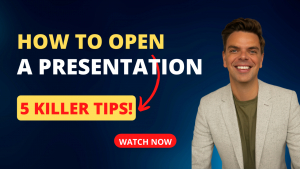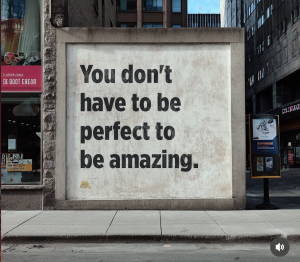-
.
Displaying items by tag: presenter training
BAFTA-Winning Production Insights for Better Business Presentations
In our years as BAFTA Award-winning television producers, we learned countless lessons about what makes content truly compelling. These weren't abstract creative principles—they were practical techniques refined through the unforgiving standards of broadcast television.
Now, working with business professionals at The Presenter Studio, we've discovered something valuable: the production insights that earned us industry recognition translate directly into more effective business presentations.
Here are the key lessons from behind the camera that can transform what you do in front of an audience.
Insight 1: Pre-Production Determines Success
In television, there's a saying: "Fix it in pre-production, not in post-production."
When we were producing BAFTA-winning content, we spent weeks planning before a single frame was filmed. We knew exactly what story we were telling, what shots we needed, what questions we'd ask, and how pieces would fit together.
The actual filming? That was just executing a carefully designed plan.
Amateur productions do the opposite. They start filming and hope to "find it in editing." The results are always weaker, no matter how much time they spend in post-production trying to rescue poorly planned content.
How this applies to business presentations:
Most business presentations fail during preparation, not delivery. People start building slides before they've clarified their core message. They haven't thought about their audience's perspective. They haven't structured their narrative arc. They're hoping to "fix it" during delivery or with impressive visuals.
At The Presenter Studio, we teach a pre-production approach to presentations:
- Define your exact objective. What specific action or decision do you want from this presentation? (In TV, we'd call this knowing your story.)
- Understand your audience deeply. What do they care about? What are their concerns? What's their knowledge level? (This is audience research—critical in television.)
- Structure your narrative. What's your opening hook? What's your core argument? What evidence supports it? What's your closing call to action? (This is your production outline.)
- Plan your key moments. Which three points absolutely must land? Where will you slow down? Where will you speed up? (These are your "money shots.")
Only after this pre-production work should you build slides or practice delivery.
We've seen executives transform their presentation effectiveness simply by applying television-level pre-production discipline. The content often stays similar, but it's now structured for maximum impact instead of random information delivery.
Insight 2: The First 30 Seconds Are Everything
In television, we obsessed over openings. We knew that if we didn't hook viewers in the first 30 seconds, they'd change the channel. No second chances.
This led to a specific discipline: every piece of content had to open with something immediately interesting. A provocative statement. A compelling visual. An intriguing question. A surprising fact.
We never opened with context or setup or background. We opened with the most interesting thing we had, then provided context after we'd earned attention.
How this applies to business presentations:
Most business presentations open terribly.
"Good morning everyone. Thanks for joining. Today I'll be covering three topics. First, some background on the project. Then we'll look at methodology. Finally, we'll review findings."
This is the equivalent of a TV show opening with: "Welcome to this documentary. In the next hour, we'll explore several themes related to our topic. Let's begin with some historical context."
No one would watch past the first 15 seconds.
Here's what we teach instead, using our broadcast production approach:
Open with your most compelling point. The surprising finding. The bold recommendation. The provocative question. The specific benefit to your audience.
Example transformation:
Before: "Thanks for being here. Today I'm going to present Q3 results and discuss strategic implications for the coming quarter."
After: "Our customer acquisition cost dropped 47% this quarter. That's not a typo - forty-seven percent. Let me show you exactly how we did it and why this changes everything about our growth strategy."
Which would you pay attention to?
Insight 3: Show, Don't Tell (Literally)
Television is a visual medium. One of the first things you learn in production is: if you can show it, show it. Don't have someone describe a beautiful location—show the location. Don't have someone explain how something works—show it working.
During our BAFTA-winning projects, we spent enormous effort finding ways to visualize complex information. Abstract concepts became concrete demonstrations. Data became graphics. Explanations became sequences.
Not because it looked pretty. Because visual information is processed 60,000 times faster than text, and is remembered far longer.
How this applies to business presentations:
Business presentations are typically text-heavy. Slides full of bullet points. Speakers reading information that audiences could read faster themselves.
This is the opposite of television's "show, don't tell" principle.
When we work with executives at The Presenter Studio, we push them toward visual demonstration:
- Instead of listing benefits, show a before-and-after comparison
- Instead of describing a process, walk through a specific example
- Instead of presenting data in tables, create a simple visual that reveals the pattern
- Instead of explaining a concept, demonstrate it with a prop or analogy
One client was presenting a complex operational efficiency improvement. His original presentation was 30 slides of process flows and data tables. We helped him restructure around three specific examples that demonstrated the improvement in action. Same information, radically different impact.
The television producer's instinct - "How can we show this instead of telling it?" - transforms presentations.
Insight 4: Pacing Is an Active Choice, Not an Accident
In television editing, pacing is deliberate. Fast cuts create energy and excitement. Slow sequences create tension or allow emotional moments to breathe. The best productions vary pacing strategically—moments of intensity followed by moments of reflection.
When we were producing award-winning content, we'd spend hours in editing adjusting pace. A few seconds here or there completely changed how content felt.
Pacing wasn't something that "just happened." It was crafted.
How this applies to business presentations:
Most business presenters have one pace: steady and moderate. They move through all content at roughly the same speed, regardless of what they're covering.
This is exhausting for audiences. It's like watching a film where every scene has identical pacing—no variation, no rhythm, no dynamic range.
We teach television-style pacing variation:
- Speed up through background information and context
- Slow down dramatically for your key points
- Pause completely after important statements
- Pick up pace when telling stories or examples
- Decelerate as you approach your conclusion
One technique we borrowed directly from television editing: the "two-beat pause." After delivering your most important point, pause for two full beats (roughly two seconds). This feels uncomfortably long when you're presenting. It's perfect for your audience—giving them time to absorb what you just said.
In television, we'd hold on a significant visual for those extra beats. In presentations, you hold in silence. Same principle, same impact.
Insight 5: Technical Quality Affects Credibility
Here's something we learned producing for BAFTA consideration: technical quality isn't just aesthetic. It affects how seriously audiences take your content.
Poor audio makes viewers question content quality. Bad lighting makes even compelling stories feel amateurish. Shaky camera work undermines credibility.
This isn't shallow. It's psychological. Audiences unconsciously use production quality as a proxy for content quality.
How this applies to business presentations:
When you're on video calls with poor lighting and bad audio, audiences unconsciously perceive you as less credible and less senior—regardless of what you're saying.
When your slides are cluttered and amateur-looking, people doubt the quality of your thinking.
When your physical presence is low-energy, audiences assume your ideas lack energy.
At The Presenter Studio, we apply television production standards to business presentations:
For video presence:
- Invest in basic lighting (even a £30 ring light transforms presence)
- Use a good microphone (laptop mics undermine credibility)
- Frame yourself properly (learn the rule of thirds from photography)
- Create an uncluttered background (or use tasteful blur
The Evolution of Presenter Training: From TV Studios to Corporate Stages
Twelve years ago, when we founded The Presenter Studio as BAFTA Award-winning television producers, our mission was clear: train the next generation of TV presenters.
We'd spent years in television production, working with celebrity talent and creating broadcast content. We knew what made someone compelling on screen. We understood the specific skills that separated good presenters from great ones.
Our first clients were exactly who we expected: people with dreams of television careers. Aspiring presenters who wanted to break into broadcasting. Actors who needed stronger on-camera skills. People who'd been told they had "screen presence" and wanted to develop it professionally.
We loved this work. Television was our world, and we were passing on hard-won expertise from our BAFTA-winning production careers.
Then the industry started shifting beneath our feet.
The First Pivot: When TV Started Changing
Around 2015, we began noticing something concerning. The television industry—particularly traditional broadcasting—was contracting. Streaming was rising. YouTube was creating new types of presenters. The pathway into television presentation was becoming less clear.
Meanwhile, our phones started ringing with different types of calls.
"We saw your TV presenter training," a corporate communications director said. "Could you teach our executives those skills?"
Initially, we were hesitant. We were television professionals, not business trainers. Would our expertise even translate?
We decided to experiment. We brought a senior leadership team through a modified version of our TV presenter training—on-camera techniques, message clarity, vocal variety, purposeful movement.
The results surprised us. These executives weren't preparing for television, but the skills transformed how they presented to their boards and teams. One participant later told us: "I've been presenting for twenty years, but no one ever taught me these techniques. This changed everything."
We started to realize something important: the skills that make TV presenters effective aren't specific to television. They're fundamental communication skills that work everywhere.
Understanding the Problem
As we worked with more corporate clients, we identified the core issue they faced.
Business professionals are often brilliant strategists, subject matter experts, and decision-makers. They have important things to say. But they'd never been taught how to deliver those messages compellingly.
They'd learned public speaking in school (maybe), picked up some presentation tips from colleagues, and mostly just figured it out as they went along. The result? Competent but forgettable presentations. Information delivered but not remembered. Good ideas that didn't get buy-in because the delivery didn't match the quality of the thinking.
Meanwhile, TV presenters receive extensive training in exactly these skills. They learn how to structure messages for impact, use their voice as an instrument, command attention, handle pressure, and connect with audiences.
Why shouldn't business professionals have access to that same expertise?
The Second Wave: Video Becomes Unavoidable
Around 2018-2020, video communication exploded in business. What had been occasional conference calls became daily video meetings. What had been rare media interviews became regular social media presence.
Suddenly, every executive was on camera constantly—but almost none of them had on-camera training.
This is when we saw the real value of our television production background. We'd spent years understanding what works on screen versus in person. We knew the specific adjustments people need to make for camera presence. We understood lighting, framing, energy projection through a lens, and where to direct your gaze.
These weren't abstract concepts from our TV days—they were immediately practical skills that every professional needed.
Our corporate training evolved again. Now we weren't just teaching presentation skills. We were teaching broadcast-level on-camera performance for business contexts.
What We Kept from Our TV Roots
As we evolved from training TV presenters to training business professionals, we realized certain elements of our approach were universally valuable:
High Standards In television production, there's no room for "pretty good." Content either works or it doesn't. We brought those same standards to corporate training. We don't accept mediocre presentations just because someone is "not naturally a presenter." We expect excellence because we know it's achievable.
Specificity TV training is concrete. "Make eye contact with the camera lens for three seconds." "Pause for two beats after your key message." "Lower your vocal pitch at the end of statements." We don't deal in vague advice like "be more confident." We teach specific, actionable techniques.
Practice Under Realistic Pressure TV presenters don't just talk about performing under pressure—they practice it repeatedly. We brought this same approach to corporate training. Our clients present on camera, get feedback, and present again. They practice recovery when things go wrong. They build muscle memory for techniques.
Focus on Authenticity The best TV presenters aren't performers in the theatrical sense. They're authentically themselves, just optimized. We never try to turn people into something they're not. We help them become the most effective version of themselves.
What We Added for Corporate Clients
Working with business professionals also taught us new elements that now define our approach:
Business Context Understanding We had to learn the specific scenarios our clients face. Board presentations operate differently than investor pitches. Team meetings require different skills than media interviews. We studied business communication the way we once studied television formats.
Integration with Business Strategy Unlike aspiring TV presenters who needed general skills, executives needed presentation training that supported specific business objectives. We learned to connect communication skills with strategic outcomes.
Scalability Television typically trains individuals. Businesses needed us to train teams, develop internal capability, and create lasting change across organizations. We built programs that could scale while maintaining quality.
Measurement of Impact Business clients rightfully asked: "What's the ROI?" We developed ways to measure improvement and connect presentation skills to business results—something we'd never needed to do in television.
Where We Are Now
Today, The Presenter Studio serves primarily corporate clients, but our identity remains rooted in our television production heritage. We're still BAFTA Award-winning producers who've worked with celebrities and created broadcast content.
That background is our competitive advantage.
When we teach an executive how to handle difficult questions, we're drawing on years of managing celebrity interviews and media incidents. When we coach someone on on-camera presence, we're applying techniques refined through countless hours of television production. When we help someone tell a compelling story, we're using narrative principles from our BAFTA-winning work.
We're not business consultants who added presentation training to their services. We're television professionals who discovered that broadcast-level communication skills are exactly what business leaders need.
The Unexpected Benefit of Our Evolution
Here's something we didn't anticipate: working with corporate clients made us better at what we do.
In television, you can succeed with strong technical skills. But in business, we had to deeply understand why these techniques work. We had to be able to explain the psychology of attention, the neuroscience of storytelling, and the mechanics of credibility.
Teaching executives—many of them skeptical about "presentation training"—forced us to become more precise, more practical, and more results-focused.
Now when we do train aspiring TV presenters (we still work with some), we're actually better at it than we were twelve years ago because we understand the underlying principles more deeply.
What the Next Twelve Years Might Hold
We're now watching new shifts in how people communicate. Virtual reality presentations. AI-generated content. New platforms we can't yet imagine.
But we've learned something important from our journey: the fundamentals of effective human communication remain constant even as mediums change.
Whether you're presenting on television, in a boardroom, on a video call, or in whatever medium emerges next, you still need to:
- Capture and hold attention
- Deliver messages clearly
- Connect authentically
- Project credibility
- Handle pressure gracefully
- Tell compelling stories
These skills transcend any specific platform. They're human skills, not technical skills.
That's why we're confident The Presenter Studio will remain relevant regardless of how communication technology evolves. We teach fundamentals that have been valuable for as long as humans have been communicating, refined through the demanding standards of professional television production.
The Bottom Line
We didn't plan to evolve from TV presenter training to corporate presentation skills. The market pulled us in this direction because business professionals recognized the value of broadcast-level communication training.
Looking back, we're grateful for how things unfolded. We get to use our BAFTA-winning television production expertise to create real business impact. We help executives become more effective leaders, companies communicate more powerfully, and professionals advance their careers.
We're still television people at heart. We still think like producers, train like we're preparing someone for broadcast, and maintain the high standards that won us awards.
But now we apply that expertise where it can make the biggest difference: helping business professionals communicate with the same skill and impact as the best television presenters.
And honestly? That feels like exactly the right evolution.
The Presenter Studio brings 12 years of evolution and BAFTA-winning television expertise to corporate presentation training. Discover how broadcast-level skills can transform your business communications.
Why TV Presenter Skills Matter in the Boardroom
When we founded The Presenter Studio 12 years ago as BAFTA Award-winning television producers, our focus was training aspiring TV presenters. We taught autocue reading, camera presence, and broadcast delivery techniques.
Then something interesting happened. Corporate executives started approaching us.
"Can you teach us what you teach TV presenters?" they'd ask. "We need to present to boards, investors, and large teams. We need to be as compelling as people on television."
Initially, we weren't sure our TV expertise would translate. We were wrong. It translates perfectly. Here's why television presenter skills have become essential for business success.
The Attention Economy Hit Business Hard
Television presenters have always competed for attention. Change the channel and they're gone. They learned to be compelling within seconds or lose their audience.
Now business presenters face the same challenge. Your board members have phones buzzing with notifications. Your team is on video calls with email open in another window. Your investors are evaluating multiple opportunities simultaneously.
The skills TV professionals use to capture and hold attention—strong openings, strategic pauses, vocal variety, purposeful movement—aren't just nice to have anymore. They're essential for ensuring your message even gets heard.
Video Is Now the Default Communication Medium
Remember when "presenting" meant standing in a conference room with slides? Those days are gone.
Now you're on Zoom calls, recording video messages, appearing in company broadcasts, and maybe even doing media interviews or conference speaking. You're on camera constantly—just like a TV presenter.
Yet most businesspeople never learned on-camera skills. They don't know where to look, how to frame themselves, or how to project energy through a lens. TV presenters master these skills as fundamentals. Business professionals need them just as urgently.
Through our work at The Presenter Studio, we've seen countless executives transform their video presence by applying simple broadcast techniques—proper camera positioning, energy projection, and the specific eye contact patterns that work on screen versus in person.
Authenticity Has Become a Competitive Advantage
Here's an interesting paradox: TV presenters are trained performers, yet the best ones seem completely authentic. How?
They've learned to be genuinely themselves while optimizing their delivery. They know how to eliminate distracting habits without becoming robotic. They understand how to project their authentic personality in a way that translates through cameras and reaches audiences.
Business leaders face the same challenge. Stakeholders are sophisticated. They can spot inauthentic corporate speak immediately. Yet completely unrehearsed presentations often ramble or miss key messages.
The solution? The TV presenter's approach: deep preparation that allows for authentic delivery. Know your message so thoroughly that you can deliver it conversationally. This is exactly what we teach in our corporate presentation training.
Storytelling Has Moved from "Nice to Have" to "Must Have"
Television professionals understand something fundamental: facts alone don't persuade. Stories do.
A TV documentary doesn't just present information. It takes you on a narrative journey with tension, resolution, and emotional connection. This isn't manipulation—it's how human brains process and remember information.
Business presentations increasingly require the same approach. Investment pitches need narrative arc. Change management communication needs emotional resonance. Strategy presentations need to take audiences on a journey.
We've worked with CEOs who had brilliant strategies but couldn't get buy-in. The problem wasn't their thinking—it was their presentation. Once we applied storytelling techniques from our BAFTA-winning television production background, those same strategies suddenly became compelling. The content hadn't changed. The delivery had.
Recovery Under Pressure Is a Daily Requirement
TV presenters work with the knowledge that anything can go wrong—teleprompters fail, guests don't show up, technical issues arise—and they must handle it gracefully while maintaining credibility.
Business leaders face similar pressures. A key slide doesn't load. Someone asks a hostile question. The presentation time gets cut in half. A crisis emerges mid-meeting.
The executives who handle these moments well share something with professional broadcasters: they've trained for recovery. They have techniques for maintaining composure, pivoting smoothly, and turning problems into opportunities to demonstrate competence.
This is why we incorporate "crisis scenarios" into our corporate training. We learned from years of television production that you can't train someone to "stay calm under pressure" with advice alone. You need to create realistic pressure situations and practice recovery techniques until they become automatic.
Personal Brand Now Matters for Everyone
TV presenters have always understood that they are their brand. Their credibility, trustworthiness, and likability directly impact their career success.
This reality has now extended to business professionals. Your presentation style shapes how you're perceived as a leader. Your video presence influences whether people trust your judgment. Your ability to communicate vision determines whether teams follow you.
We've seen talented executives plateau in their careers not because they lack strategic thinking, but because they lack presentation skills. They're perceived as less confident, less visionary, or less credible than they actually are—simply because they never learned on-camera techniques.
Meanwhile, others accelerate their careers by mastering these skills. They're the same person with the same capabilities, but now they're perceived differently because they present differently.
The Skills Are Learnable (Not Innate)
Here's the most important thing we've learned training both TV presenters and business professionals over 12 years: these skills are completely teachable.
People assume TV presenters are naturally charismatic or comfortable on camera. They're not. They've been trained in specific techniques—where to look, how to modulate their voice, how to use gestures purposefully, how to structure content for impact.
When we teach these same techniques to executives, they develop the same capabilities. The CFO who seemed stiff becomes compelling. The technical director who rambled becomes clear and concise. The CEO who struggled with credibility starts commanding rooms.
The difference between an effective presenter and an ineffective one isn't talent. It's training.
What This Means for Your Organization
If your business requires people to present - to boards, investors, clients, teams, or the public - then TV presenter skills are no longer optional professional development. They're core business skills.
The executives who present well get buy-in for their ideas. They inspire their teams. They represent your organization credibly. They advance their careers and contribute to organizational success.
Those who present poorly - even if they're brilliant strategists - struggle to get ideas heard, teams engaged, or stakeholders convinced.
At The Presenter Studio, we've built our entire methodology around translating professional broadcast techniques into practical business applications. We know these skills matter because we've seen the career and organizational impact when people master them.
The Bottom Line
The lines between television presentation and business presentation have dissolved. You're on camera regularly. You compete for attention constantly. You need to be authentic, compelling, and credible under pressure.
These were always requirements for TV presenters. Now they're requirements for business success.
The good news? Everything TV professionals know about effective presentation is learnable. You don't need natural charisma or performance background. You need the right training from people who understand both broadcast excellence and business context.
That's exactly what we provide.
Ready to bring television-level presentation skills to your business? The Presenter Studio's BAFTA-winning team specializes in translating broadcast techniques into corporate impact.
What Working with Celebrities Taught Us About Presentation Training
Over our 12 years as BAFTA Award-winning television producers, we've had the privilege of working with numerous high-profile celebrities. While we can't name names, we can share the fascinating lessons these experiences taught us about what truly makes someone compelling on screen—and how those insights transformed our approach to presentation training.
Lesson 1: Charisma Isn't What You Think It Is
Early in our production career, we assumed celebrities were naturally magnetic. We were wrong.
Working with an A-list actor on a documentary series, we discovered something surprising: off-camera, they were softly spoken and reserved. But the moment filming began, they transformed. Not through volume or energy, but through something more subtle—absolute presence in the moment.
What this taught us: Charisma isn't an inherent trait. It's a skill of being fully present and genuinely interested in your message and audience. We now teach business presenters this exact technique. The executives who seem most "naturally charismatic" after our training aren't extroverts—they're the ones who learn to be completely present rather than thinking ahead or worrying about judgment.
Lesson 2: Authenticity Beats Perfection
We once worked with a beloved television personality who insisted on doing multiple takes for every segment, convinced they needed to be "perfect." The results were strangely flat. When we convinced them to do just one take, accepting any small stumbles, the footage was electrifying.
The imperfections made them human. The real-time thinking made them relatable.
What this taught us: We stopped teaching corporate clients to memorize presentations word-for-word. Instead, we teach the "TV presenter's approach"—know your key messages deeply, but allow yourself to find the words in the moment. Business audiences don't want polish; they want authenticity. A small stumble followed by a genuine smile is more compelling than robotic perfection.
Lesson 3: The Pre-Performance Ritual Matters
Almost every celebrity we've worked with has a pre-camera ritual. One would do specific breathing exercises. Another would shake out tension while making unusual facial expressions. A third would pace and talk to themselves.
At first, these seemed like quirks. Then we realized: these rituals weren't about superstition. They were about reaching a specific mental and physical state before performing.
What this taught us: We now build personalized "pre-presentation rituals" with every client. For one executive, it's two minutes of power poses. For another, it's a specific breathing pattern. For a third, it's reviewing three photos that remind them why their message matters. The ritual itself matters less than having a reliable way to access your optimal state.
Lesson 4: "Difficult" People Are Usually Just Scared
We worked with one celebrity who had a reputation for being challenging. They questioned everything, resisted direction, and seemed defensive. Productions dreaded working with them.
During our project, we realized something: underneath the difficult behavior was profound fear of looking foolish. Once we demonstrated that our direction made them look better, not worse, they became collaborative and generous.
What this taught us: When business clients resist presentation training—"I don't need this" or "This feels unnatural"—it's rarely arrogance. It's fear. Now we address that fear directly: "It's completely normal to feel uncomfortable. Every celebrity we've worked with feels this way initially. Let's make this safe to experiment."
This shift in approach transformed our results. Resistant clients become our biggest success stories once they feel psychologically safe.
Lesson 5: The Best Performers Obsess Over Feedback
The celebrities who remained at the top of their field shared one trait: they were insatiable for feedback. After every take, they'd ask: "How was that? What can I adjust? Did that moment land?"
The ones whose careers faded? They assumed they already knew.
What this taught us: We now build feedback loops into all our corporate training. We record presentations, review them together, and celebrate improvements. The executives who transform fastest aren't the naturally gifted ones—they're the ones who actively seek feedback and iterate.
One CEO we trained watched herself present, winced, and said, "I look so stiff!" Instead of being defensive, she asked, "What specific changes would help?" Six months later, her board commented on her "remarkable transformation." She had the same attitude toward improvement that we'd seen in world-class celebrity talent.
Lesson 6: Environment Shapes Performance
On set, we learned that celebrities perform differently depending on the environment we create. Harsh lighting and a tense crew produce tight, self-conscious performances. Warm lighting and a supportive atmosphere unlock natural brilliance.
What this taught us: We help companies redesign their "presentation environment." This means everything from room setup to how feedback is given in rehearsals. One client was struggling with team presentations. The issue wasn't skill—it was that they rehearsed in a stark conference room with fluorescent lighting while colleagues scrolled phones. We changed the environment, and performances improved immediately.
Lesson 7: Recovery Is More Important Than Mistakes
Every celebrity we've worked with has flubbed lines, lost their place, or had technical issues on camera. The difference between professionals and amateurs isn't avoiding mistakes—it's how quickly they recover.
The best celebrities would acknowledge a mistake with a quick smile, reset, and continue without dwelling on it. That recovery became part of their charm.
What this taught us: We now spend significant training time on recovery techniques. What do you do when you lose your place? How do you handle a technical failure? What's your response when someone asks a question you can't answer?
Business presenters who master recovery actually appear more confident than those who never make mistakes. Audiences relate to graceful recovery. It's human.
The Bottom Line
Working with celebrities didn't teach us that some people are simply "born presenters." It taught us the opposite: the most compelling communicators use specific, learnable techniques. They prepare ritually, welcome feedback, embrace authenticity over perfection, and practice recovery.
At The Presenter Studio, we've spent 12 years translating these insights from celebrity-level television production into practical training for business professionals. The techniques that work for on-screen talent work for everyone—because they're based on how human communication actually works, not mystical "natural talent."
Want to present with the confidence and impact of the on-screen talent we've trained? Discover how The Presenter Studio's BAFTA-winning approach can transform your presentation skills.
On-Camera Techniques Every Business Presenter Should Steal from TV Professionals
As BAFTA Award-winning television producers, we've spent over a decade coaching on-screen talent and creating broadcast content. One thing has become crystal clear: the techniques that make TV presenters compelling work just as powerfully in business presentations.
Here are five professional broadcast techniques you can use immediately to transform your next presentation.
1. The "Three-Second Rule" for Eye Contact
Professional TV presenters know they have three seconds to connect with viewers before attention drifts. They achieve this through intentional, sustained eye contact with the camera lens.
How to apply this in business: When presenting, hold eye contact with individual audience members for a full three seconds before moving on. This creates genuine connection rather than the "scanning the room" effect that makes audiences feel unseen. If you're on video calls, look directly at your camera lens when making key points, not at faces on screen.
We learned this working with celebrity talent who could command a room instantly. The secret wasn't charisma—it was disciplined eye contact technique.
2. "Marking the Script" for Natural Delivery
In television production, we teach presenters to mark their scripts with breath marks, emphasis points, and pause indicators. This prevents the robotic delivery that plagues so many business presentations.
How to apply this in business: Before any important presentation, go through your notes and mark:
- Forward slashes (/) where you'll pause for breath
- CAPITALS for words you'll emphasize
- Underlines for phrases that need slower delivery
- Asterisks (*) for moments to smile or gesture
This simple technique - used by every professional broadcaster - transforms written content into natural, conversational delivery. Your audience won't notice the technique, but they'll feel the difference.
3. The "Active Listening Face"
Watch any skilled TV interviewer and you'll notice something: their face is never blank, even when they're not speaking. They've mastered the "active listening face" - subtle expressions that show engagement and encourage the speaker.
How to apply this in business: During meetings, video calls, and Q&A sessions, consciously maintain an engaged expression. Slight nods, raised eyebrows at surprising information, and micro-smiles at appropriate moments signal that you're truly present. This technique, refined through years of celebrity interviews, makes others feel heard and creates rapport instantly.
Many executives think neutrality projects professionalism. Actually, it projects disinterest. TV professionals know that visible engagement builds trust.
4. "Pre-Framing" Your Key Messages
In broadcast television, we never let important information appear randomly. We pre-frame it: "What I'm about to show you is remarkable..." or "Here's the most important thing to understand..."
This technique - called "signposting" in TV production - alerts viewers that something significant is coming. Their attention sharpens immediately.
How to apply this in business: Before delivering crucial information, budget requests, or recommendations, use pre-framing phrases:
"This next point is critical to our success..."
"What I'm about to share will change how we think about..."
"The key insight from our research is..."
We've coached countless executives who bury their most important points mid-presentation. TV professionals never make this mistake. They signal importance before delivering it.
5. The "Reset Gesture"
Professional presenters use a physical "reset gesture" between topics—a deliberate movement that signals transition and recaptures attention. It might be stepping to a different position, changing hand gestures, or adjusting posture.
How to apply this in business: When moving between presentation sections, use a physical transition:
- Take two steps to the side
- Change from standing to sitting (or vice versa)
- Shift from gesturing broadly to keeping hands still
- Move to a different area of the room
This technique, perfected in television studios where holding attention is everything, gives audiences a mental "chapter break" and refreshes their focus. We've seen it rescue presentations that were losing momentum.
The Bottom Line
These aren't gimmicks - they're battle-tested techniques from an industry where every second of audience attention matters. At The Presenter Studio, we've refined these methods through BAFTA-winning production work and training everyone from TV celebrities to corporate leaders.
The best part? Once you learn these techniques, they become automatic. You'll present with the polish and confidence of a broadcast professional, because you're using their exact methods.
Ready to master these techniques and more? The Presenter Studio offers corporate presentation training that brings television industry expertise to your business communications.
How To Master Your Opening: First Impressions That Last
A strong presentation begins with a memorable opening. Many speakers underestimate how crucial the first minute is, yet neuroscience and communication research show that audiences form strong opinions very early on. To master your opening you must connect with your audience emotionally and intellectually.
Begin with a story that resonates with your audience, or a startling statistic that challenges their assumptions. Use language that draws the audience into a question or scenario they care about.
Avoid generic “Today I will talk about…” phrases. When you start with an anecdote or real-life example you humanise your topic immediately, making your message more relatable.
Your opening should also establish what the audience should expect and why it matters to them. Clarity early on builds trust and keeps attention anchored. Poor openings often lead to wandering attention or loss of credibility. To practice strong openings try recording your first minute, listen back and ask whether it would grab someone who didn’t know the content. With repeated refinement you will learn what works in your style.
If you really want to elevate your opening, consider specialist training to refine delivery, message framing and audience connection. For more guidance on improving presentation skills through professional coaching visit https://www.presenterstudio.com/business-presenter-training/presentation-skills-training
The Next Big CBBC Presenter? We Think So!
We are hugely proud of this presenter showreel at The Presenter Studio.
Kai first came on our one day how to make it as a TV presenter workshop and we thought he was great…he's naturally funny warm and friendly and basically a TV producer's dream.
So we chatted to Kai about coming on our one to one advanced programme which includes a meeting where we discuss you come up with a strategy and a plan of attack for your career and then we go away and write bespoke scripts and come up with a schedule for a filming day.
We filmed with Kai all across London in South London central London in some really great locations, showcasing his fun quirky quick witted comedic style but at the same time keeping it warm and friendly.
We've branded and marketed him for kids TV we really think he could do incredibly well. He feels like the next wave of those great BBC presenters and we're excited for his future.
So please check out the showreel that we did for him https://youtu.be/SNax-vDjsU4 and please comment and share below.
Presentation Skills - 3 Top Tips
So I saw two presentations this week and I wanted to share my thoughts on both...as I think there are lots of helpful learnings here and lots of tips to share from us at The Presenter Studio.
1 When it comes to your presentations make sure they reflect the tone the feel of the brand that you're representing. We were lucky enough to hear from the team at wework which for me is an innovative energetic and young working space so therefore you'd expect the presentation to feel young and energetic.
2 Get your presentations off to a pacey dynamic start. If the opening of your presentation drugs lacks focus lacks engagement the audience quickly decides to be more passive in the session and not active in their listening first impressions really do count on many level.
And 3 – Slides! It's so surprising how many presenters rely so heavily on slides yet they can really feel old fashioned they can pull the focus and often visually they don't reflect the brand that you are representing. So if you are going to use slides ask yourself why do I need them do they reflect the visual nature of our brand and never present to the slide always present to the audience.
Hope these tips and tricks help!
#presentationskills #presentations #presentercoach #presenter
Check out our latest Presenter Showreel
Check our latest presenter showreel from the team at The Presenter Studio...
This was for psychotherapistSophie Scottwho first came on the 1 day How to Make it as a Presenter workshop (next date is June 25th).
And then did the 1 to 1 with us where we shot the footage for her showreel.
We think it's amazing.
See what you think!
Huge congrats and thanks Sophie!
The future is bright...
https://www.youtube.com/watch?v=SCeJiBf5kxI&feature=youtu.be










